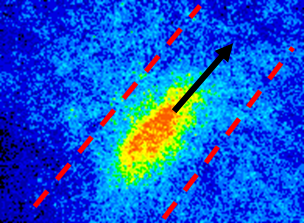A first step towards imaging of circulating tumor cells


Tumor cells labeled with near infrared QDs Left: ex vivo (scale bar: 5 µm). Right: In vivo, circulating at about 1 mm/s in a blood vessel, thanks to time-gated imaging.
Imaging isolated cells is a critical issue in biomedical studies, in particular in the case of circulating tumor cells. Many techniques exist (MRI, PET…) which are costly and not sensitive enough to detect isolated cells. Fluorescence imaging is a flexible imaging modality but its sensitivity remains limited by the autofluorescence background from the surrounding tissues. Researchers from the LPEM and LPC, at ESPCI, recently designed a new fluorescence modality to remove this fluorescence background and image single cells circulating in the blood stream.
They use near infrared fluorescent semiconductor quantum dots (QDs) with specific optical properties, including a long fluorescence lifetime of typically 150-200 ns, which is much longer than the fluorescence lifetime of intrinsic fluorophores from biological tissues. This property, coupled to a time-gated fluorescence microscope, enables efficient rejection of autofluorescence photons and detection of later photons from the QD-labeled cells. This considerably increases sensitivity and enables imaging isolated circulating tumor cells flowing in the blood stream at high velocities, up to 1 mm/s, within the flow of normal blood cells. Now, specific in vivo, not ex vivo, QD labeling of circulating tumor cells should be developed. Future developments of this technique include studying the effects of drugs on these cells, as well as other applications such as tracking immune or stem cells, or quantitative in vivo imaging of enzymatic activity.
In Vivo Imaging of Single Tumor Cells in Fast-Flowing Bloodstream Using Near-Infrared Quantum Dots and Time-Gated Imaging
Thomas Pons, Sophie Bouccara, Vincent Loriette, Nicolas Lequeux, Sophie Pezet, and Alexandra Fragola
ACS Nano, 2019, 13 (3), pp 3125–3131. DOI : 10.1021/acsnano.8b08463
Contact:
Thomas PONS, ![]()
Alexandra FRAGOLA, ![]()
